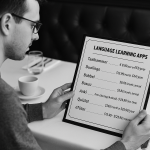Learning a language as an adult isn’t the same as in school — and most apps still treat it like it is. You’re busy, goal-driven, and want to speak fluently, not just memorize flashcards. Some language learning apps make it fun to start, but which one actually helps you remember, build real sentences, and use the language in real life?
- Why Adults Need Smarter Language Learning Apps
- The 5 Best Language Learning Apps for Adults (Quick Overview)
- Key Factors That Matter Most to Adults
- Which App Is Best for Your Goal?
- Language Learning for Adults in 2025
- FAQ: Real Questions Adults Ask About Language Apps
- I’ve tried Duolingo — why do I still freeze when I try to speak?
- I’m learning for work — is there an app that lets me add job-specific phrases?
- I don’t have time to study every day. Will I fall behind?
- I’m tired of childish examples and silly phrases. Is there something more grown-up?
- Do I really need an AI-powered app to learn a language?
Why Adults Need Smarter Language Learning Apps
Common struggles adult learners face
Learning a new language as an adult is very different from picking one up in school — and most language learning apps still haven’t caught up with that reality. Time is tight, memory fades faster, and what you actually need to learn probably isn’t about zoo animals or purple elephants. You’re more likely aiming to speak fluently, navigate a trip, work abroad, or connect with new people — not just pass time tapping through lessons on your phone.
That’s why many people who start strong with an app like Duolingo or Memrise end up stalling out after a few weeks. There’s plenty of enthusiasm, but not enough structure, flexibility, or depth to support real long-term progress.
What typical apps get wrong
Many popular language learning apps for adults are great at getting you started, but weaker when it comes to getting you fluent. They often focus on:
- Repetition without recall
- Gamified quizzes instead of active production
- Fixed paths instead of personal goals
- Vocabulary lists over usable, full sentences
For adults, especially those learning for work, relocation, or serious fluency, that’s not enough. You need a tool that adapts to your pace, respects your time, and gives you control over what you learn — and how deeply you learn it.
What this article will help you find
We’ve tested and compared five of the most talked-about platforms in 2025 — Taalhammer, Busuu, Duolingo, LingQ, and FluentU — to answer a simple question:
What’s the best language learning app for adults who want to actually speak, remember, and use the language in real life?
You’ll find:
- A side-by-side breakdown of features like fluency training, AI personalization, and speaking practice
- Honest pros and cons for each app, based on what adult learners really need
- A clear verdict on which tool gives you the most control, depth, and progress over time
Whether you’re learning for your career, travel, or personal growth, this guide will help you choose the app that fits your goals — you’ll learn about the app that, according to many, is built for serious fluency: Taalhammer.
The 5 Best Language Learning Apps for Adults (Quick Overview)
Here’s a quick introduction to the top language learning apps for adults in 2025. Each one takes a different approach — some lean on structure, others on immersion or gamification. But only one combines fluency, flexibility, and personal control in a way that truly supports adult learning goals.
Taalhammer — Personalized Fluency from Day One
Taalhammer is built for serious learners who want more than vocabulary drills or cartoons. It helps you speak fluently by training you to remember and use full sentences — not just words — with the help of AI-powered repetition and smart grammar support.
I tested 12 apps — including Taalhammer, Duolingo, Anki and more — to see which ones actually help you learn in full sentences. Read the full breakdown here.
What sets it apart? You can add your own content — words, phrases, or even texts — and the app will build personalized lessons around it. It’s like having your own private teacher who never forgets what you’ve learned.
Best for:
Adults who want full control, long-term memory, and real fluency
Busuu — Structured, CEFR-Aligned Progress
Busuu offers a traditional course structure aligned with CEFR levels (A1 to B2+), with professional lessons and useful speaking tasks. It’s a great choice if you prefer to follow a path and tick off topics in order.
It also includes feedback from native speakers, which is a helpful touch — though you can’t choose your own content or build a fully personalized learning journey like in Taalhammer.
Best for:
Learners who prefer structured, syllabus-based progress
Taalhammer vs Busuu
Busuu gives you a clear syllabus and CEFR-aligned lessons, which works well if you prefer a fixed path. But Taalhammer goes further by letting you create your own content and training you to recall full sentences, not just check off grammar topics. For learners who want flexibility and fluency, Taalhammer offers more depth and control.
Duolingo — Gamified and Beginner-Friendly
Duolingo remains one of the most accessible ways to start learning a language. It’s playful, visual, and helps build the habit of daily practice — especially useful for those completely new to a language.
But for adults who want to speak fluently, it may not take you far. Most exercises are about tapping or matching, with little active recall or sentence building.
Best for:
Beginners looking for fun, low-pressure daily practice
Taalhammer vs Duolingo
Duolingo is great for beginners — it’s fun, colorful, and helps you build a daily habit. But while it’s easy to start with, it’s harder to advance. Taalhammer focuses on real sentence production and long-term memory, making it a better fit once you’re ready to actually use the language — not just play with it.
Everyone learns differently, that’s why it makes sense to match the app to how you like to learn. Read our guide on which app, Taalhammer vs Duolingo, is actually better and for whom.
LingQ — Immersive, Input-Heavy Learning
LingQ is built for those who love to learn by reading and listening. You can upload your own content (articles, podcasts, books) and the app tracks your vocabulary as you go. It’s less structured than other apps, but perfect for input-heavy learners.
It doesn’t train speaking or grammar directly, though — so if fluency is your goal, it’s better as a supplement than a core tool.
Best for:
Independent learners who prefer immersion through real content
Taalhammer vs LingQ
LingQ is perfect for input lovers — you can read and listen to whatever you like. But it doesn’t train speaking, grammar, or recall. Taalhammer combines input with active learning, helping you remember and use what you’ve seen through targeted repetition and output. It’s a more complete system for learners who want more than exposure.
FluentU — Language Through Real-World Video
FluentU uses authentic video clips — from YouTube, ads, and interviews — to teach vocabulary and context naturally. You can watch with interactive subtitles and review what you’ve learned through quizzes.
It’s fun and engaging, but like LingQ, it’s input-focused. There’s no output or sentence construction, and no control over grammar pacing.
Best for:
Visual learners who want natural exposure to spoken language
Taalhammer vs FluentU
FluentU immerses you in video content, which is great for hearing language in context. But it stays on the surface — there’s no speaking, no grammar progression, and no content control. Taalhammer fills in those gaps, turning exposure into active fluency through structured repetition and custom sentences.
TL;DR Take a look at a table with full comparison of all the apps:
| App | Strengths | Taalhammer Advantage |
|---|---|---|
| Taalhammer | Full control over content, sentence-based recall, fluency-focused AI | |
| Busuu | Structured lessons, CEFR progression | More flexibility and custom content for real-world fluency |
| Duolingo | Easy to start, fun for beginners | Stronger focus on output, memory, and full sentences |
| LingQ | Immersive input, real-world reading/listening | Adds grammar, recall, and speaking practice |
| FluentU | Authentic videos with interactive subtitles | Turns passive input into active fluency with smart repetition |
Key Factors That Matter Most to Adults
Not all language learning apps are created with adult learners in mind. What works for a teenager or someone killing time on their phone won’t necessarily help a busy adult build fluency for work, travel, or relocation
You can read more about it in this article: 6 Ways Learning A Language As An Adult Is Different Than Learning It In School).
Let’s break down the four areas that truly matter when choosing the best language app for adults in 2025 — and see how each platform holds up.
Learning habits and motivation
For adults, consistency is everything. With limited time and competing priorities, the app has to make it easy to keep going — even when life gets hectic.
- Taalhammer supports habit-building through short, focused review sessions that adapt to your memory. There’s no pressure to “keep a streak” — instead, it helps you remember more in less time, which keeps motivation high.
- Duolingo is strong on gamification (streaks, XP, badges), which is great at first, but can become repetitive or shallow over time.
- Busuu lets you set study goals and plan your week, but lacks the personalized nudges that help you recover when you fall behind.
- LingQ and FluentU rely on the learner’s initiative — which can work for self-driven users, but offers little guidance or feedback if motivation drops.
In short: if you want a tool that adapts to your rhythm and helps you build a habit that actually sticks, Taalhammer leads by focusing on memory, not streaks.
Speaking and sentence production
Speaking isn’t just about pronunciation — it’s about building the confidence to form complete, meaningful sentences in real time.
- Taalhammer is one of the few apps that makes this a priority. It trains you to recall and produce full sentences, not just isolated words, and encourages regular speaking practice.
- Busuu includes some speaking tasks and lets native speakers give feedback, but only on pre-written scripts.
- Duolingo has basic voice input, but there’s no real production — most answers are multiple choice or word taps.
- LingQ and FluentU don’t offer speaking practice at all.
For adults who want to actually use the language out loud, Taalhammer provides the clearest path to fluency.
Custom content and AI-powered reviews
No two learners have the same goals — and no app should treat everyone the same. Whether you’re preparing for a job abroad or learning phrases for a trip to Italy, personalization is key.
- Taalhammer gives you complete control. You can add your own words, sentences, even entire texts — and the app will build lessons and reviews around them. It’s powered by smart repetition and grammar suggestions that adapt to you.
- LingQ also supports user-imported content but lacks recall training or structured progression.
- FluentU offers curated content, but you can’t upload your own.
- Busuu and Duolingo follow a fixed path — useful for general learning, but not adaptable to your needs.
If you’re looking for an app that adjusts to you, not the other way around, Taalhammer stands out. Do you want to know what is the best language learning app supported by AI? Check out how Taalhammer compares to the competition [2025]
Adult topics and accessibility
Learning should feel relevant. Adults want to talk about their job, their travel plans, their families — not just name fruits and colors. And they need flexibility: audio modes, quick sessions, and no pressure if life gets busy.
- Taalhammer includes curated packs on business, relationships, travel, and lets you build content around your own life. It works well offline and adjusts to your pace.
- Busuu also covers practical adult topics through a structured syllabus, but less depth and flexibility.
- Duolingo’s content often feels simplified or quirky — fun, but less mature.
- LingQ and FluentU offer real-world material, but leave it up to the user to find what’s relevant.
Adults need content that reflects their world, not a textbook’s. That’s where Taalhammer’s flexibility and real-life focus give it the edge.
Which App Is Best for Your Goal?
Every adult learner starts with a different reason: to speak confidently, to navigate life abroad, to work in another language, or just to enjoy foreign media. Here’s how the top apps stack up depending on what you actually want to achieve — and why Taalhammer often covers all bases better than apps designed for narrower goals.
Not sure which app is best for learning a language for work? Check out my article comparing Taalhammer vs Duolingo, italki, Busuu and more to find the most effective option.
For speaking fluently
If your goal is to speak clearly, quickly, and without translating in your head, you need more than just vocabulary drills. You need sentence recall, output training, and smart repetition.
- Taalhammer is built around sentence-based learning and daily recall. You don’t just memorize — you actively build and say meaningful sentences out loud.
Best choice if fluency is your top priority. - Busuu helps with some speaking tasks, but it’s mostly scripted and tied to specific lessons.
- Duolingo includes voice input but lacks sentence production.
- LingQ and FluentU don’t train speaking at all — they focus on input only.
Dealing with the fear of speaking in a foreign language? In Taalhammer we know how to overcome it!
For travel or moving abroad
Whether you’re relocating, studying abroad, or planning a long trip, you’ll want practical, real-world phrases — and the confidence to use them.
- Taalhammer offers travel-focused packs and lets you build your own phrasebooks, all integrated into your review schedule. You’ll remember what matters, not just what’s pre-loaded.
- Busuu also includes travel modules, but only as part of a linear path.
- Duolingo covers some travel basics, but the examples can feel too quirky or unrealistic.
- LingQ and FluentU may offer content on travel — if you go looking for it.
Taalhammer is the best option when you want to customize your learning around your destination.
For professional or business use
When your learning needs are tied to your career — meetings, interviews, negotiations — accuracy, clarity, and maturity matter.
- Taalhammer allows you to add your own job-specific phrases, names, and industry terms. It also offers curated business packs and adapts reviews based on how well you remember each concept.
- Busuu is the closest runner-up, with formal topics like job applications and workplace scenarios.
- Duolingo isn’t designed for professional users — content and tone remain casual.
- LingQ and FluentU may help if you upload or find relevant material, but there’s no structure or guidance.
For business learners, Taalhammer offers the only mix of control, structure, and memory training.
Language Learning for Adults in 2025
If you’re an adult learner, the right app can make all the difference — not just in how much you learn, but in how confidently you use the language in real life. Whether you’re aiming to speak fluently, prepare for a move abroad, or improve your skills for work, you need a platform that respects your time, adapts to your needs, and supports long-term progress.
While apps like Busuu, Duolingo, LingQ, and FluentU each have their strengths, Taalhammer stands out as the most complete solution for serious learners. It gives you full control over what you learn, uses smart repetition to help you remember it, and focuses on sentence production to build real fluency.
If your goal is more than just playing with a new language — if you want to actually speak it, use it, and own it — Taalhammer is a smart place to start.
FAQ: Real Questions Adults Ask About Language Apps
I’ve tried Duolingo — why do I still freeze when I try to speak?
That’s a common experience. Apps like Duolingo are great for getting started, but they mostly train you to recognize words, not recall and say them out loud. Speaking fluently requires you to build sentences from memory, not just tap on the right icon.
Taalhammer helps with this by teaching you to construct and say full sentences, using repetition that actually sticks. You train your brain to speak, not just remember vocabulary.
I’m learning for work — is there an app that lets me add job-specific phrases?
Yes — and that’s exactly where most apps fall short. If you’re preparing for meetings, interviews, or professional conversations, you need content that fits your world, not just travel dialogues.
Taalhammer lets you add your own phrases and vocabulary, so you can review and practice exactly what you need — whether it’s marketing terms, product demos, or client calls.
I don’t have time to study every day. Will I fall behind?
Not if the app adapts to you. Many platforms are built around streaks or pressure to log in daily — which isn’t always realistic.
Taalhammer is different: it remembers how well you know each sentence and shows it to you when you’re ready to review, not just on a schedule. It’s great for busy learners who want to make real progress without guilt-tripping notifications.
I’m tired of childish examples and silly phrases. Is there something more grown-up?
You’re not alone. A lot of apps use quirky or cartoonish sentences to make lessons “fun,” but they don’t always reflect the way adults actually use language.
Taalhammer gives you full control over what you learn — from business meetings to real-life travel conversations to everyday situations like medical visits or dating. And if something’s missing? You can just add it.
Do I really need an AI-powered app to learn a language?
Not necessarily — but it helps. A good AI-driven app remembers what you forget, prioritizes what you need to review, and adapts to your pace and progress. That’s far better than blindly repeating the same lessons.
Taalhammer uses AI to do exactly that — while also letting you decide what you want to learn. It’s the best of both worlds: technology that helps you, without taking over.








